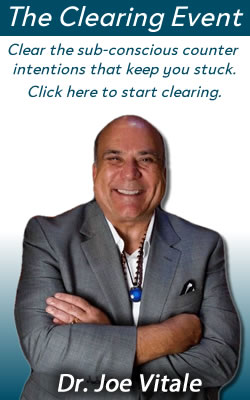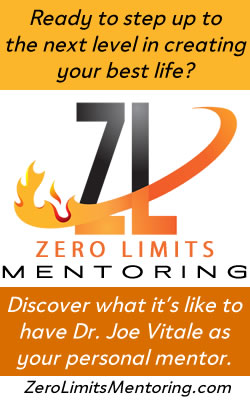Dr. Joe Vitale’s Blog
The Most Contented Man
My father passed away last month. He was 93. One of my proudest moments was turning him into an author when he was age 90. Here is that moment:
Wealth Attraction Secrets
I’m excited to say Andres Pira and I have completed the book “Homeless to Billionaire.” It reveals his 18 wealth attraction secrets. You can pre-order it at his site right now: https://andrespira.com/
About Miracles Coaching
People are always asking about my famous Miracles Coaching program, which I started more than ten years ago. Here’s a brief video overview of it. You can learn more at http://www.MiraclesCoaching.com
Healing with Ho’oponopono
My presentation a few years ago on ho’oponopono is still the second most popular video I’ve ever posted. It was after my book, Zero Limits, and before the sequel, AT Zero. If you missed it, here it is again:
The Big Idea – 5 Steps to Take Control
This is an absolute classic…5 Steps to Take Control. From my appearance on the Donny Deutsch show. Rapid fire Life Mastery. #VitaleLifeMastery #TakeAction#InspiredAction #ExpectMiracles
Check it out!
Speaker 1: Next, one of the stars of The Secret steps up to the bully pulpit to help you take control of your destiny.
Joe Vitale: Well, this is powerful because most people don’t know they have counter beliefs within themselves.
Donny Deutsch: We’ve been talking about chaos and control all night. Okay, now I’m gonna light a fire under you to take control and make those millions. I’ve got the high octane jet fuel motivation for you right now. Joe Vitale. He’s a guy that gets paid thousands of dollars to inspire people to go for their dreams. He’s one of the starts of the wildly successful inspirational DVD “The Secret”. He’s written more than 30 motivational books, and his newest book, The Key, sold more than half a million copies in three months.
Joe Vitale, welcome to The Big Idea, man.
Joe Vitale: Hey. Thank you for having me.
Donny Deutsch: You’re a guy who’s gone from being homeless …
Joe Vitale: Yeah.
Donny Deutsch: … sleeping in doorways, to a guy who’s making millions, so nobody knows more about taking control than you. Let’s give the secrets for those folks at home about taking control.
Number one.
Joe Vitale: Number one is, “Watch your show.” I gotta tell you, I opened for Donald Trump in Chicago just a couple weeks ago. I have 30 minutes to talk. I could be promoting my own books, my Miracles Coaching program. What do I do? I say, “Everybody here should be watching Donny Deutsch.”
Donny Deutsch: We like that one.
Joe Vitale: Yeah.
Donny Deutsch: Okay.
Joe Vitale: So I got five steps that I tell people. Okay?
Donny Deutsch: Doing that.
Joe Vitale: The very first step is, “Know what you don’t want.” Now that may sound obvious. You may be sitting there complaining about everything, but you gotta know that is your benchmark. You use that as your spring to go to number two.
Number two is, “Check your intention.” Intentions are powerful, Donny. Intentions rule the earth. When you state an intention, you realign your body and mind to go in the direction of a new target. That’s powerful.
Donny Deutsch: So getting on all that stuff you were saying. Start with-
Joe Vitale: Yeah.
Donny Deutsch: When you … Give me an example of what, “Okay, I don’t want this, so now I’ve gotta refocus to my intention.”
Joe Vitale: Well, no. It … A lot of people are complaining about they don’t want their bills, they don’t want to be unemployed, they want more money coming in, they want more clients, they wanna feel better. There’s all kinda complaints.
Most people leave it on the level of a complaint. Stop complaining. In fact, take the 21 day challenge that’s in the book, a complaint free world, and stop complaining. Instead, turn it around and do what you do want. So if you don’t want all the bills, what do you want instead? You want enough cash to pay for those bills. State a new intention for what you want. Then you start going in the direction of that, a new intention.
The third step is to “get clear”. Now this is powerful, because most people don’t know they have counter beliefs within themselves. Counter intentions, Donny. They may say, “I want success,” but inside themselves, they may be saying, “I don’t deserve success.” They may say they want money, but you may be telling yourself, “Money is bad. Rich people are evil. Corporations are out to get everybody.” You gotta clean that up. When you clean that up, you go in the direction of what you want. Now you’re clear. So the third step, Donny, is to get clear.
The fourth step is to what I call, “‘Nevelize’ your goal.” “Nevelize” your goal means to feel what it would be like to already attain the thing you want. So if you have the more money coming in, you got more sales coming in, you got a big deal, you end up on Donny Deutsch’s show, you got some kinda great success, at that point, what does that feel like? When you anchor the feeling within yourself, you are accelerating the process of going to it. You kick in your passion. Passion rules. Passion is your ticket to success. You know that. I know that. You out there probably already know that.
The fifth thing that you wanna do is you let go while taking inspired action. Now this is important to understand. Letting go means you’re letting go of desperation, your addiction, your attachment to the end result. All you wanna do is focus on your passion. When you focus on your passion, you naturally take the actions. You must take action. Too many people, maybe some of the people who are watching right now, are just sitting there. They’re not taking action going for what they want.
Those are the five steps.
Donny Deutsch: It’s easy to say, “Take action.” I’m listening to Joe at home …
Joe Vitale: Yeah.
Donny Deutsch: …. and going, “Hey, you know, I’d love to visualize that new car or that new company I’m gonna start. I’d love to get rid of my bills and turn that into cash, and” … But how do you then …
I go, “Okay, I’m in it. I’m with you. Let’s go, boy. Well, let’s do it.” How do I … How do I get it going? How do … What does that all mean?
Joe Vitale: Yeah.
Donny Deutsch: Translate that for me.
Joe Vitale: Okay. Well, the first thing, we gotta go back to step three. So we’ve already gone through the first couple steps. I know what I don’t want. You know what you do want. The third step is getting clear, so there’s a lotta garbage that you just put up there. You were just saying, “I don’t know what I’m gonna do. I don’t know what the next steps are. I don’t know what to do, what action to take.”
When you get clear of the beliefs within yourself that are questioning your own deservingness and your own attitudes towards money or attitudes towards success, your attitudes towards wealthy people and wealth in itself, then you get cleared up so that you know what the actions are, and I say the actions you take, Donny, are inspired action, not just any old action.
Inspired action means it comes from in here. It comes from inside your heart. It comes inside your passion, your soul. The very soul of your being will tell you what to do next, and it’s unique to you, and it may be something like … You had a woman on your show one time who invented this purse, and she got this wild idea. I don’t know that I would have done it, but it was for her. She got on a plane and went to China with no appointments. She didn’t know anybody over there. She went by herself, she got off the plane, and she made cold calls in China to find somebody to make her product. That was inspired action unique to her. Your inspired action will be unique to you. You pay attention to what your intuition is saying, what your gut is saying, and that’s what you act on. Thank you.
Donny Deutsch: Joe Vitale, bestselling author, a guy who was down on his butt, back up, making millions. You could do it, too. More big ideas right ahead.



